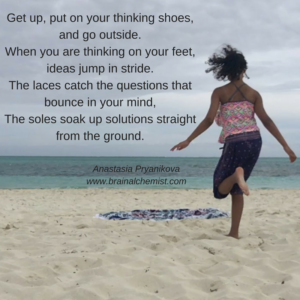Your lizard brain on vacation: How environment builds the brain
 Have you noticed how certain habits and routines change when you change your surroundings, for example, when you go on vacation? Your environment constantly shapes your brain and your habits whether you are aware of it or not.
Have you noticed how certain habits and routines change when you change your surroundings, for example, when you go on vacation? Your environment constantly shapes your brain and your habits whether you are aware of it or not.
In his book “Situations Matter,” Sam Sommers argues that by understanding the powerful influence that context has in our lives and using this knowledge to rethink how we see the world, we can be more effective at work, at home, and in daily interactions with others.
Today, I bring you my observations about the power of environment to change our habits from the beautiful island of Providenciales in Turks and Caicos, where my daughter and I have recently spent a blissful week of vacation.

 overwhelmed, do you sometimes complain, procrastinate and not take any action at all (or spend hours on social media)? And all this time, you are building resistance. You are not alone. Many people can relate to this experience. Resisting and complaining sap your energy. Whenever you feel the build-up of resistance, you want to stop and think about how you can transform that inner resistance into strength and action.
overwhelmed, do you sometimes complain, procrastinate and not take any action at all (or spend hours on social media)? And all this time, you are building resistance. You are not alone. Many people can relate to this experience. Resisting and complaining sap your energy. Whenever you feel the build-up of resistance, you want to stop and think about how you can transform that inner resistance into strength and action.

 You begin by preparing your dry plant ink. For my ink, I used dry rose petals, chamomile flowers and lavender flowers that I often use to brew teas. Dry herbs, spices, tea leaves are all good options. You can crumble the dry plants with your hands or use a rolling pin.
You begin by preparing your dry plant ink. For my ink, I used dry rose petals, chamomile flowers and lavender flowers that I often use to brew teas. Dry herbs, spices, tea leaves are all good options. You can crumble the dry plants with your hands or use a rolling pin. I like to collect my dry plant ink into a mesh sachet bag. I may even through a few of my favorite crystals into the mix. When not in use, you can keep such sachet on your desk for its beautiful aroma, which will serve as another reminder to your brain of your set intentions. (
I like to collect my dry plant ink into a mesh sachet bag. I may even through a few of my favorite crystals into the mix. When not in use, you can keep such sachet on your desk for its beautiful aroma, which will serve as another reminder to your brain of your set intentions. (





 environment. This is also true in the context of public speaking, especially for speakers who may experience social anxiety.
environment. This is also true in the context of public speaking, especially for speakers who may experience social anxiety.